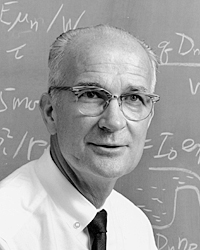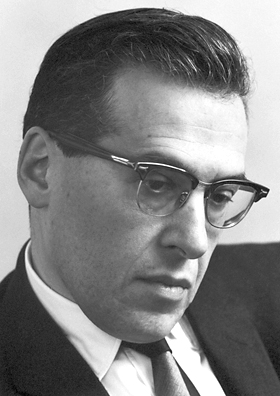Julian Schwinger
January 29, 2015
As I've remarked in a few previous articles,
geniuses don't think like ordinary people, but they're surprised when their
conjectures aren't embraced by everyone. A recent example of this is
James D. Watson, co-discoverer of the
structure of
DNA with
Francis H. Crick and a recipient of the 1962
Nobel Prize in Physiology or Medicine. Watson has espoused some controversial opinions linking certain
genetic traits with others. In 2000, as a guest lecturer at the
University of California, Berkeley, he expressed his belief that
dark-skinned people have greater
libido.[1]
In that same lecture, Watson said that "Whenever you interview
fat people, you feel bad, because you know you're not going to hire them."[1] I offer myself as a
counterexample, since I'm a somewhat overweight, but supposedly productive, individual. Watson, moreover, caused a severe firestorm in 2007 when he suggested that people of
African descent are not as
intelligent as
white people.[2-3]
Surprisingly, Watson wasn't the first
Nobel laureate to conflate genetics and personality traits. In his later years,
William Shockley, who shared the 1956
Nobel Prize in Physics for the
invention of the
transistor, was an advocate of
eugenics. There may have been a mitigating circumstance for Shockley's unusual behavior. Some have theorized that it may have been the result of a
brain injury from a 1961
automobile accident. Shockley had even become estranged from his
children, who only learned of his death in 1989 from
news reports.

William Shockley in 1975.
(Stanford News Service photo by Chuck Painter, via Wikimedia Commons.)
These are extreme examples, but a Nobel Laureate need not stray that far from his
science to get into trouble. One thing that
physicists are known for is their belief that proper application of
physics can
revolutionize any field of science, and they're surprised when their advice is not accepted.
Sheldon Cooper of
The Big Bang Theory is like that.
Julian Schwinger (1918-1994) was a preeminent
theoretical physicist. He shared the 1965
Nobel Prize in Physics with
Richard Feynman and
Sin-Itiro Tomonaga "for their fundamental work in
quantum electrodynamics (QED), with deep-ploughing consequences for the physics of
elementary particles."[4] In his final years, Schwinger became interested in
cold fusion, a controversial topic that I discussed in a
previous article (Martin Fleischmann, August 10, 2012).
Schwinger decided to use his knowledge of elementary particle physics to devise some
hypothetical ways in which cold fusion might be possible, so that they could be tested by
experiment. He was not allowed to
publish his
hypotheses in the usual venues, such as
Physical Review Letters, so he thought that cold fusion research was being suppressed for being non-conventional. Schwinger resigned from the
American Physical Society, publisher of the
scientific journals that rejected his papers.
That happened more than two
decades ago. Although the proponents of cold fusion are still claiming positive results, cold fusion has still not been unequivocally demonstrated to the satisfaction of its critics. Still, we shouldn't let this detract from Schwinger's other accomplishments.
Edward Gerjuoy, an
emeritus professor of physics of the
University of Pittsburgh, has just published a lengthy
memoir of Schwinger on
arXiv.[6]

Julian Schwinger in 1965, the year in which I graduated from high school.
Schwinger received his Ph.D. from Columbia University at the youthful age of twenty-one. His thesis advisor was I.I. Rabi.
(Nobel Foundation photograph, via Wikimedia Commons.)
Julian Schwinger was born in
New York City, to
Orthodox Jewish parents. He briefly attended the
City College of New York, eventually getting a
bachelor's degree from
Columbia University in 1936. As Gerjuoy recalls, the transfer to Columbia was necessitated by Schwinger's proclivity for skipping class and only taking exams.[6]
I.I. Rabi, who was impressed by Schwinger's knowledge, was instrumental in bringing Schwinger to Columbia. Rabi, as quoted by Gerjuoy, wrote,
"I... got a transcript from City College, and took it to one of the officials—I forget who it was. Now what about a fellowship, scholarship for this guy? He looked at the transcript and said, on the basis of this we wouldn't admit him. I [then] said something very tactless—I said, suppose he were a football player...Still the problem remained...[but] I just simply overrode them and he was admitted."[6]
Schwinger remained at Columbia, getting a
Ph.D. in 1939, at the age of twenty-one, under Rabi. It's been said that the work for his Ph.D.
thesis was actually completed three years prior to this![6] He worked for
J. Robert Oppenheimer as a
National Research Fellow and
postdoc at the University of California, Berkeley, from graduation through the time of his first academic appointment, as an
Instructor at
Purdue University in 1941.[7] Oppenheimer had a reputation for ruthlessly asking pointed questions of his students when they were
seminar speakers. Gerjuoy writes that Schwinger had no trouble answering Oppenheimer's questions.[6]
During
World War II, Schwinger worked, not at Oppenheimer's
Los Alamos Laboratory, but on
radar at the
MIT Radiation Laboratory. Gerjuoy writes that Schwinger didn't go to Los Alamos because he feared that Oppenheimer would try to dominate him.[6] After the war, Schwinger taught at
Harvard University from 1945 to 1974, first as an
associate professor, then as a
full professor.[7] The
mathematics that he used in his radar work were supposedly a crucial factor that led to his
renormalization calculation of the
electron magnetic moment in
quantum electrodynamics.
It's been suggested that Schwinger anticipated the existence of more than one type of
neutrino.[10] One of Schwinger's students,
Fritz Rohrlich, was a professor at
Syracuse University while I was a student there. Among Schwinger's more than seventy doctoral students are four Nobel Laureates,
Ben Mottelson,
Sheldon Glashow,
Roy Glauber and
Walter Kohn.
In his arXiv paper, Gerjuoy bemoans the fact that
Richard Feynman has had more fame than Schwinger, and he gives many interesting insights into Schwinger's career. Gerjuoy writes that Schwinger essentially learned physics on his own, primarily from
books at the
public library.[7] At age seventeen, Schwinger co-authored two
Letters to the Editor of the
Physical Review.[8-9]
One thing that Schwinger had in common with me is that he liked to work late at night while others are
asleep.[7] I do this this since I'm too easily distracted by
noise, and that was perhaps Schwinger's motivation as well. This work
habit of Schwinger began during his
undergraduate years, and it was probably the reason he was chronically absent from the classroom.
References:
- Tom Abate, "Nobel Winner's Theories Raise Uproar in Berkeley," San Francisco Chronicle, November 13, 2000.
- Alexis Madrigal, "Watson Rediscovers 1940s Attitudes Towards Race' (Wired News, October 17, 2007).
- Adam Rutherford, "He may have unravelled DNA, but James Watson deserves to be shunned," The Guardian (UK), December 1, 2014.
- The Nobel Prize in Physics 1965, The Nobel Foundation Web Site.
- Julian Schwinger, "Cold Fusion Theory: A Brief History of Mine," Fourth International Conference on Cold Fusion (ICCF4, Maui, Hawaii, December 1994), via Infinite Energy Magazine.
- Edward Gerjuoy, "Memories of Julian Schwinger," arXiv, December 2, 2014
- Julian Schwinger - Biographical, The Nobel Foundation Web Site.
- O. Halpern and J. Schwinger, "On the polarization of electrons by double scattering," Phys. Rev., vol. 48, no. 1 July 1, 1935), p. 109, DOI: http://dx.doi.org/10.1103/PhysRev.48.109.
- Lloyd Motz and Julian Schwinger, "On the β-radioactivity of neutrons," Phys. Rev., vol. 48, no. 8 (October 15, 1935), p. 704, DOI: http://dx.doi.org/10.1103/PhysRev.48.704.2
- Jagdish Mehra and Kimball A. Milton, "Climbing the Mountain: The Scientific Biography of Julian Schwinger," Oxford University Press, Aug 14, 2003, p. 425.
Permanent Link to this article
Linked Keywords: Genius; conjecture; James D. Watson; nucleic acid double helix; DNA; Francis H. Crick; Nobel Prize in Physiology or Medicine; genetic trait; University of California, Berkeley; dark-skin; libido; obesity; fat people; counterexample; African descent; intelligence; intelligent; white people; Nobel laureate; William Shockley; Nobel Prize in Physics; invention; transistor; eugenics; brain injury; traffic collision; automobile accident; child; children; news report; Wikimedia Commons; science; physicist; physics; The Structure of Scientific Revolutions; Sheldon Cooper; The Big Bang Theory; Julian Schwinger (1918-1994); theoretical physics; theoretical physicist; Richard Feynman; Sin-Itiro Tomonaga; quantum electrodynamics; elementary particle; cold fusion; hypothesis; hypothetical; experiment; scientific literature; publish; hypotheses; Physical Review Letters; American Physical Society; scientific journal; decade; Edward Gerjuoy; emeritus professor; University of Pittsburgh; memoir; arXiv; Julian Schwinger; high school; Doctor of Philosophy; Ph.D.; Columbia University; doctoral advisor; thesis advisor; Isidor Isaac Rabi; I.I. Rabi; New York City; Orthodox Judaism; Orthodox Jew; parent; City College of New York; bachelor's degree; Columbia University; transcript; fellowship; scholarship; American football; football player; thesis; J. Robert Oppenheimer; National Research Council; National Research Fellow; postdoctoral research; postdoc; Instructor; Purdue University; seminar; World War II; Los Alamos Laboratory; radar; MIT Radiation Laboratory; Harvard University; associate professor; full professor; mathematics; renormalization calculation; electron magnetic dipole moment; electron magnetic moment; quantum electrodynamics; neutrino; Fritz Rohrlich; Syracuse University; Ben Mottelson; Sheldon Glashow; Roy Glauber; Walter Kohn; Richard Feynman; book; public library; Letters to the Editor; Physical Review; sleep; noise; habit; undergraduate education.